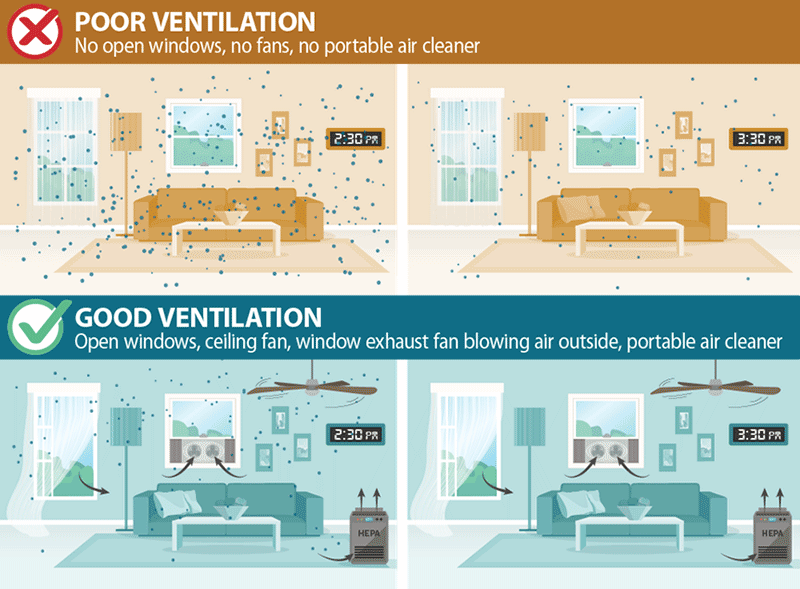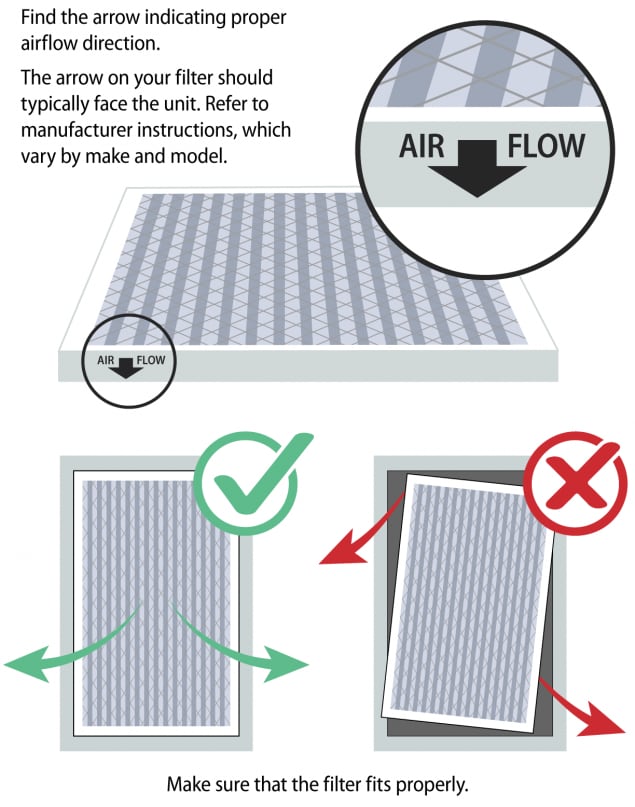Improving Ventilation in Your Home
Ventilate your home by getting fresh air into your home, filtering the air that is there, and improving air flow. Improving ventilation can help you reduce virus particles in your home and keep COVID-19 from spreading. You may or may not know if someone in your home or if a visitor to your home has COVID-19 or other respiratory viruses. Good ventilation, along with other preventive actions, can help prevent you and others from getting and spreading COVID-19 and other respiratory viruses.
How to Improve Ventilation in Your Home
Here are some ways you can improve ventilation in your home. Using as many ways as you can (open windows, use air filters, and turn on fans) will help clear out virus particles in your home faster. You can decrease particles even more by continuing to ventilate after a visitor leaves (for example, an extra hour).
Ventilation: moves air into, out of, or within a room.
Filtration: Traps particles on a filter to remove them from the air.
Bring as much fresh air into your home as possible
Bringing fresh, outdoor air into your home helps keep virus particles from accumulating inside.
- If it’s safe to do so, open doors and windows as much as you can to bring in fresh, outdoor air. While it’s better to open them widely, even having a window cracked open slightly can help.
- If you can, open multiple doors and windows to allow more fresh air to move inside.
- Do not open windows and doors if doing so is unsafe for you or others (for example, young children or pets in your home, risk of falling, people in the home with asthma or other respiratory conditions, poor air quality).
- If opening windows or doors is unsafe, consider other approaches for reducing virus particles in the air, such as using air filtration and bathroom and stove exhaust fans.
- Use fans to move virus particles in the air from inside your home to outside. Don’t leave fans unattended with young children.
Filter the air in your home
If your home has a central heating, ventilation, and air conditioning system (HVAC, a system with air ducts that go throughout the home) that has a filter, do the following to help trap virus particles:
- In homes where the HVAC fan operation can be controlled by a thermostat, set the fan to the “on” position instead of “auto” when you have visitors. This allows the fan to run continuously, even if heating or air conditioning is not on.
- Use pleated filters. Pleated filters are more efficient than ordinary furnace filters and can be found in hardware stores. Follow the manufacturer’s instructions to replace the filter yourself or ask a professional for help.
- Make sure the filter is installed properly (see figure).
- Change your filter every three months or according to the manufacturer’s instructions.
- Ideally, have the ventilation system inspected and adjusted by a professional every year to make sure it is operating efficiently.
Consider using a portable air cleaner
Using a portable high-efficiency particulate air (HEPA) cleaner can provide filtration if you don’t have an HVAC system or can improve filtration if you do have an HVAC system. They are the most efficient filters on the market for trapping particles that people exhale when breathing, talking, singing, coughing, and sneezing.
When choosing a HEPA cleaner, select one that is the right size for the room(s). Look for one that has a Clean Air Delivery Rate (CADR) that meets or exceeds the square footage of the room(s) in which it will be used. The larger the CADR, the faster it will clean the air. See EPA’s Guide to Air Cleaners in the Home for more information.
Turn on the exhaust fan in your bathroom and kitchen
 [PNG - 225 KB]
[PNG - 225 KB]With good ventilation, the concentration of virus particles in the air will be lower and they will leave your home faster than with poor ventilation.
Exhaust fans above your stovetop and in your bathroom that vent outdoors can help move air outside. Although some stove exhaust fans don’t send the air to the outside, they can still improve air flow and keep virus particles from being concentrated in one place.
- Keep the exhaust fan turned on over your stovetop and in your bathroom if you have visitors in your home.
- Keep the exhaust fans turned on for an hour after your visitors leave to help remove virus particles that might still be in the air.
Use fans to improve air flow
- Place a fan as close as possible to an open window blowing outside. This helps get rid of virus particles in your home by blowing air outside. Even without an open window, fans can improve air flow.
- Point fans away from people. Pointing fans toward people can blow contaminated air directly at them.
- Use ceiling fans to help improve air flow in the home whether or not windows are open.
Limit the number of visitors in your home and the time spent inside
The more people inside your home, and the longer they stay, the more virus particles can accumulate.
- Limit the number of visitors in your home to reduce the accumulation of virus particles in the air.
- Gather in larger rooms or areas where people can be spaced apart and keep visits short.
- Follow additional recommendations for preventing the spread of COVID-19.
Watch ASL Video: Improving Ventilation in Your Home
